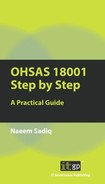APPENDIX H: SAMPLE PROCEDURE FOR FORK-LIFT TRUCKS
Purpose:
- To define a procedure for fork-lift trucks (FLTs) used by Safe and Sound Inc. (SSI), so as to ensure safety in all aspects of their operations.
Responsibilities:
Supervisor FLTs is responsible for ensuring maintenance, implementation and audit of this procedure.
Procedure:
This procedure is applicable to all three fork-lift trucks operated by Safe and Sound Inc. (SSI).
Operations:
The following precautions/controls shall be exercised for operations involving all SSI fork-lift trucks:
- Ensure that all three SSI FLTs operate within their specified load limits, and follow operating instructions specified in their respective equipment manuals.
- An out of service, or ‘unfit for use’, fork-lift truck (FLT) will be clearly marked by a large sign, to avoid unintentional use.
- An FLT will not be used if its reversing horn is not in working order.
- FLTs shall only operate on their designated and marked routes. Pedestrian crossings on these routes shall be marked with bright yellow fluorescent paint.
- All FLTs will have over-speed horns to warn the driver if the speed limit is crossed. FLTs shall have a maximum speed limit of 5km/hour.
- The driver will always be wearing a seat belt when driving a FLT.
- FLT drivers will not use mobile phones under any circumstances while driving.
- Battery charging for FLTs must be done in a designated and well ventilated area which is at least three metres away from storage of any materials, goods or equipment. All battery chargers used by SSI should be fitted with overcharge protection.
- As all SSI FLTs use diesel, their refuelling must be done in the open air, with no materials or goods within three metres of the refuelling point.
- FLT keys are not to be left in the FLT when parked and not in use.
- When not carrying a weight, FLTs shall only move with forks in the down position. Signs of ‘Both pedestrian and FLT to STOP when the distance is three metres and forks are in a raised position’ must be prominently displayed along the FLT pathways.
Maintenance:
- Designated drivers shall inspect their FLTs every day, as per checklist displayed on each FLT.
- Any sparking FLT electrical motor shall be reported immediately, and the FLT should not be used until this has been fully repaired.
- Weekly, monthly and yearly FLT inspections shall be carried out as per manuals received from suppliers.
- Records of daily, weekly, monthly and yearly inspections shall be maintained.
Training and competence of drivers:
- Only equipment specific qualified (licensed) and authorised drivers shall be permitted to drive FLTs.
- Drivers should be reassessed and retrained for practical skill and ability every two years.
- Drivers should be physically fit to drive the FLT for full duty hours.
- Drivers should have no drug addiction, and must undergo an annual medical inspection, and also an annual test for eyesight.
- Driver training and medical records must be maintained.
Auditing:
The FLT supervisor, or any other person nominated by OH&S management representative, will carry out an audit of this procedure once every year, for compliance and effectiveness. Corrective actions shall be taken without undue delay. In case of an equipment-specific non-conformity, the concerned FLT will not be used until all corrective actions have been completed and found to be effective.
..................Content has been hidden....................
You can't read the all page of ebook, please click here login for view all page.
